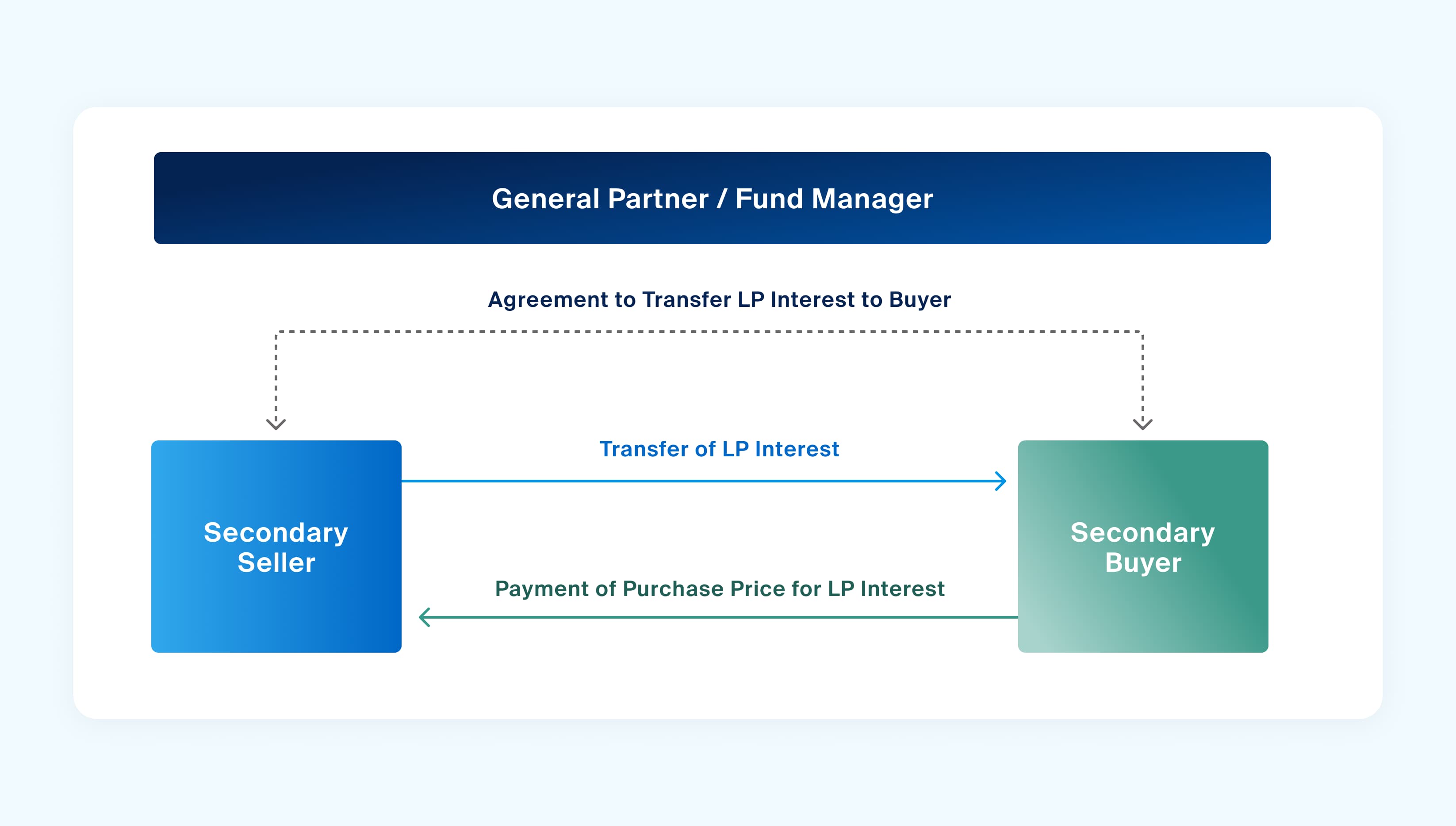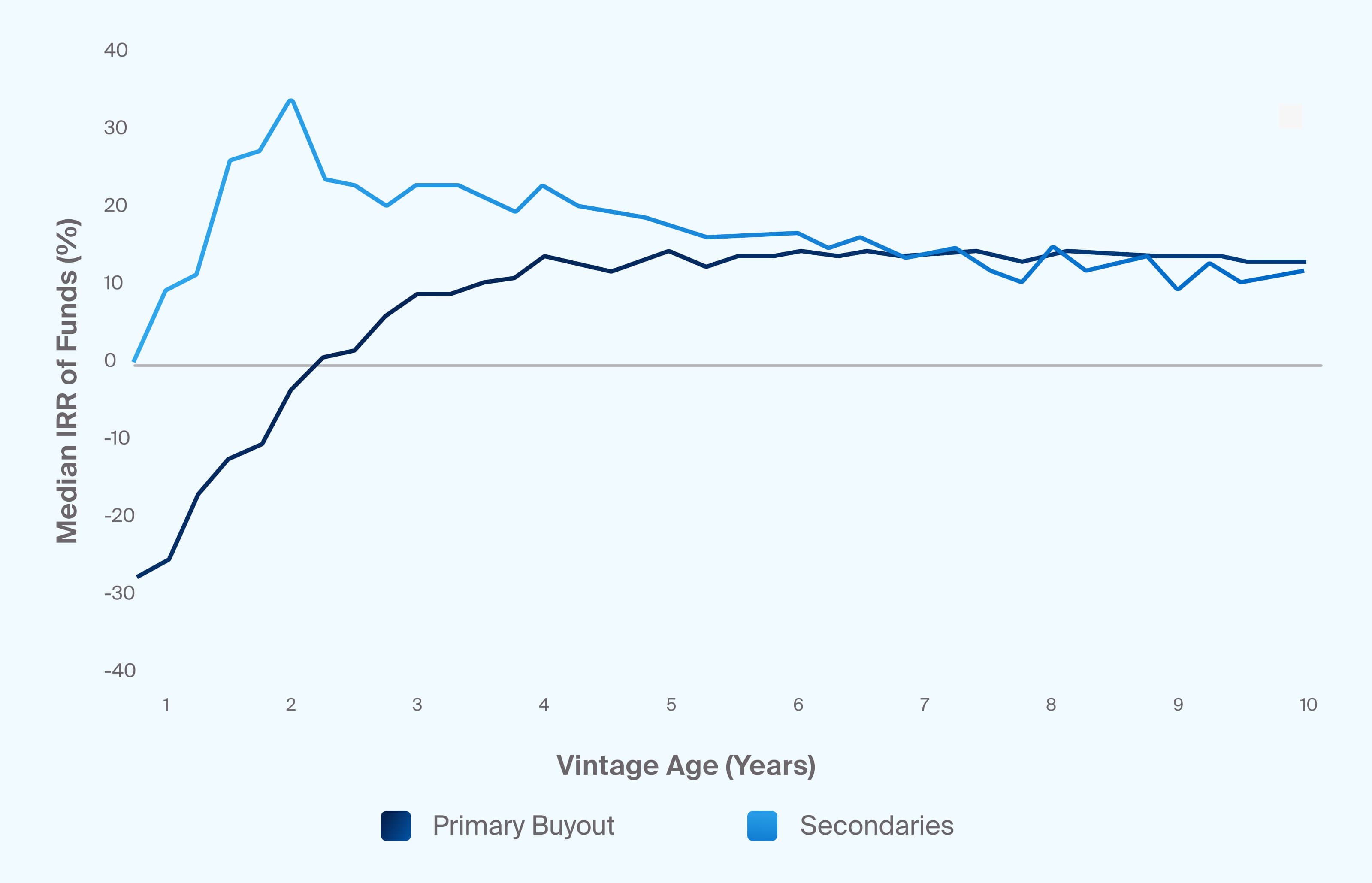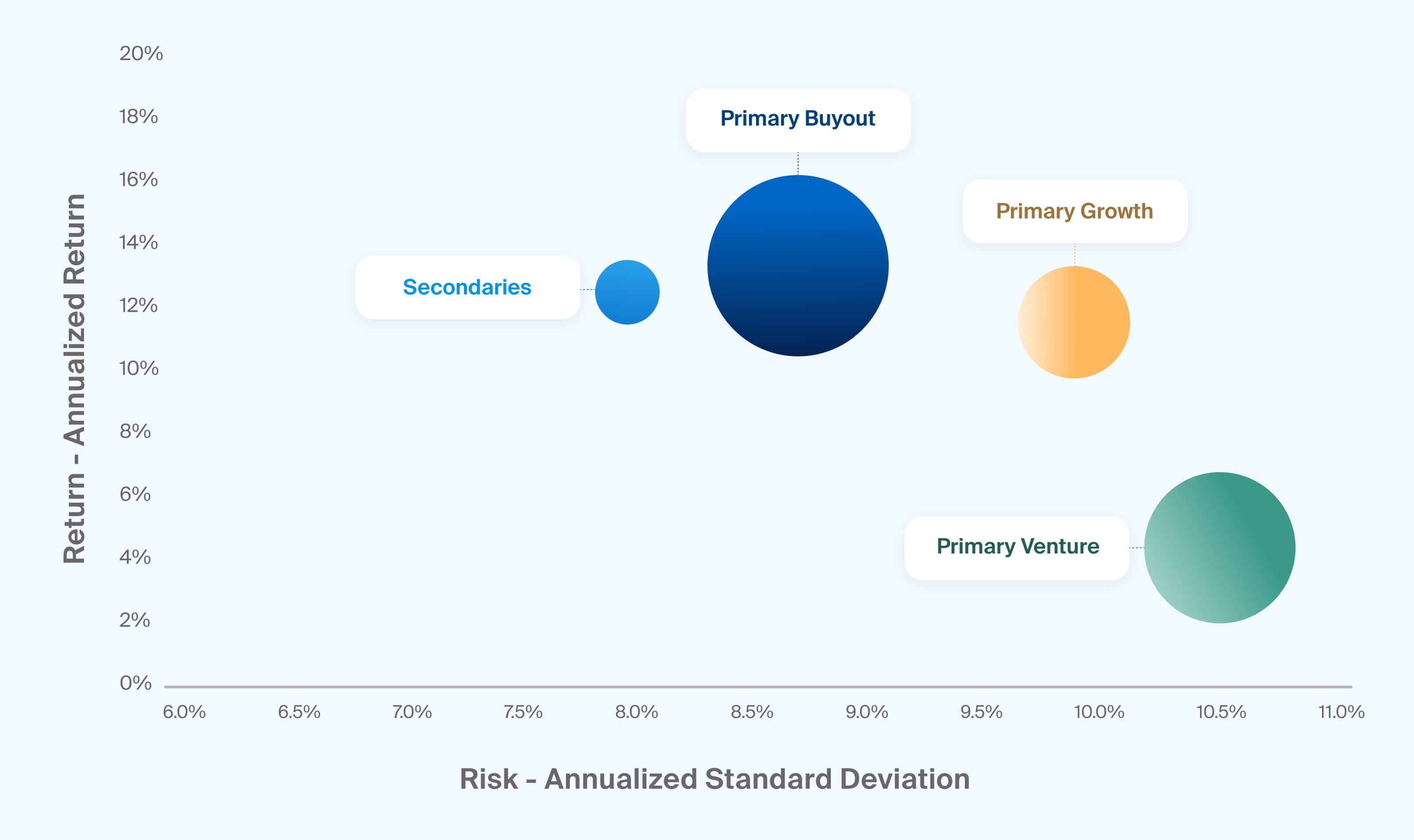Secondary investments may be an option for liquidity-minded investors who seek the return potential of private equity.
What Are Secondaries?
Secondaries generally consist of private markets investments, or existing funds comprising such investments, that transact in the secondary market. Once used only sparingly as a seller’s last resort, the private equity secondaries market has since evolved into a diversified $62-billion-a-year market with substantial transaction volume, and a strategic opportunity for those seeking greater liquidity in their portfolios.1 In many cases, sellers in the secondary market are institutional investors like foundations, endowments, pension plans, hospitals, and more.
The secondaries market is chiefly focused on private equity (PE) assets; however, other alternative asset classes and investment vehicles that use limited partnership fund structures, such as venture capital, infrastructure, or private debt, may also incorporate secondaries into their strategies.2 Within the finite-life, drawdown limited partnership structure, limited partners (LPs) generally commit capital to be later invested and managed by general partners (GPs). After fundraising is completed, typical PE funds predefine a period during which any redemptions are prohibited. For the GP, this period is generally designed to give time for investments to run their course and build incremental value into the fund’s underlying portfolio companies. Yet, for the LP, the resulting illiquidity can often limit its strategic options, especially when broader market conditions or its own financial situations change.

Source: CAIA Association, Alternative Investment Analyst Review, Introductory Guide to Investing in Private Equity Secondaries, Q3 2016.
Within the closed-end, drawdown limited partnership structure, limited partners (LPs) generally commit capital to be later invested and managed by general partners (GPs). After fundraising is completed, typical PE funds predefine a period during which any redemptions are prohibited. For the GP, this period is generally designed to give time for investments to run their course and build incremental value into the fund’s underlying portfolio companies. Yet, for the LP, the resulting illiquidity can often limit its strategic options, especially when broader market conditions or its own financial situations change.
Secondaries may be able to help to address these issues on both sides of the transaction. By allowing a particular LP or group of LPs to sell their stakes to another party, the primary fund’s GP can remain fully invested in its more promising portfolio companies. Meanwhile, the LP can sell its portion of the fund and get the cash it needs to spend or invest elsewhere. Third-party buyers, which tend to be other institutions or GPs of funds-of-funds, can also seek to benefit.
In this overview, we’ll cover the basic history and mechanics of investing in PE secondaries, including thedifferent types of secondary transactions. Later, we’ll introduce some common functions that PE secondaries may provide within a broader portfolio, as well as the risks that advisors should consider when researching opportunities within the secondary market. We will also outline ways that advisors may gain access to this growing asset class.
For more background on private equity, read “Private Equity Is No Longer a Secret,” which is also part of our Introduction to Alternatives series.
A Brief History of Secondaries
Selling investment stakes on a secondary market is nothing new in the world of financial services; the New York Stock Exchange, for instance, has served as a secondary market for public equities since the late 18th century.3 Yet, in private equity portfolios, LPs have historically been reluctant to sell out of their positions prematurely. For one, selling early in a more niche market generally meant selling at a discount to the fund’s Net Asset Value (NAV) and in some cases before any of their initial investment could be recouped. Some LPs also feared it would signal distress in their own balance sheets and possibly ruin their chances to access GPs’ future funds. That stigma has been dissolving over the last two decades, as an increasingly greater demand for secondaries has changed sellers’ motivations and as GPs have leaned into the secondary market for their own strategic reasons.4
Indeed, as noted in our article on the evolution of the secondary market, while these traditional or LP-led secondaries had once composed the bulk of the secondaries market, other types of transactions have more recently gained traction. GP-led secondaries via continuation vehicles —in which GPs actively offer their LPs the opportunity to sell to a secondary buyer or roll their stakes into a new vehicle—now make up more than 40% of the overall market.5
In general, pricing for secondary transactions is set as a percentage of a primary fund’s reported NAV on a given reference date. Depending on how the sale is negotiated by the investment management team, buyers can sometimes offer a premium or demand a discount based on their perception of the fund’s or asset’s future cash flows. As a result, pricing for secondaries is generally highly variable and can depend on many factors, including the type of transaction, the age and size of the fund or asset, the underlying investment strategy, and the reputation of the GPs managing the fund. The rise of intermediaries and exchanges also continues to impact pricing dynamics in the secondaries market.
The standard drivers of returns for PE—in particular, the use of leverage, the appreciation of assets over time, and the creation of new cash flows from underlying portfolio companies—may also play a role in secondaries performance. Because of the pricing dynamics mentioned earlier, discounts can also contribute to buyers’ ultimate returns as investments are written up to a fund’s par value.
Potential Advantages for Secondary Investors
In addition to the return potential, secondaries may offer other advantages over typical private equity investments, which we outline below.

Source: Preqin, median secondaries vintage represented by the Secondaries Private Capital Benchmark with vintages in 2000-2017, median buyout vintage represented by the Buyout Private Capital Benchmark with vintages in 2000-2017, median IRR of funds within a vintage range from 2000-2017 is calculated quarterly across the first 10 years of each fund’s lifecycle.
Because secondary buyers tend to enter a fund during the later stages of its lifecycle when underlying assets have already begun to appreciate or are sold, they may avoid the J-curve typically associated with primary PE investments. This effect may be compounded for secondary buyers who acquire their assets at a discount to NAV.
J-Curve Mitigation
See (Exhibit 2). Because secondary buyers tend to enter a fund during the later stages of its lifecycle when underlying assets have already begun to appreciate or are sold, they may avoid the J-curve typically associated with primary PE investments. This effect may be compounded for secondary buyers who acquire their assets at a discount to NAV.
Shortened Lifecycles
Secondaries generally allow for later-stage entry into funds, which can both limit remaining capital calls and shorten the amount of time that an LP must wait for distributions of capital. A continuation fund may be utilized to extend a secondaries fund reaching the end of its lifecycle so GPs can continue fund management while LPs receive greater liquidity options.
Improved Visibility
Investors in primary PE funds often commit capital with little to no insight into the fund’s underlying assets given LP commitments are made prior to the GP deploying capital to invest in companies. In contrast, secondary buyers tend to purchase shares in more seasoned funds with more observable portfolio characteristics and cash flows, allowing them to be more strategic with their investment.
Additionally, another benefit of private equity secondaries is the mitigation of “blind pool risks” since investors are investing in companies with proven track records and clear valuations.
What Are the Different Types of Secondary Investments?
Given the growth of the PE secondary market, a variety of transaction types have emerged, each with distinct attributes. Below we list some of the most common types, along with the potential benefits and risks related to each.
Traditional or LP-Led Secondaries
As described above, a traditional secondary transaction involves an LP selling its commitment before a PE fund has reached maturity. Though some LPs still sell due to unforeseen hardships and/or an inability to meet their capital calls, more recent sales have instead been driven by regulatory constraints or shifts in capital markets. For example, the Volcker Rule established in the aftermath of the Global Financial Crisis forced a number of financial institutions to sell off their private equity exposure.6 In other cases, LPs have had to rebalance their portfolios when public market downturns caused them to be overweight in their PE allocation.7
For buyers, traditional secondaries may offer diversification potential across both fund managers and underlying portfolio companies, since an LP can sell off shares in multiple primary PE funds at once. In addition, when these transactions take place relatively late in a primary fund’s lifecycle, the buyer’s investment may be shorter in duration, and thus more liquid, than comparable primary fund investments. On the other hand, the quality of the managers and funds offered in these LP-led deals may be lower on average, since many LPs remain less likely to sell out of their higher-performing positions.
GP-Led Secondaries
Similar to LP-led secondaries, a GP may also seek liquidity on behalf of their LPs and exit portfolio companies via the secondary market instead of traditional exits like an IPO or corporate acquisition. Some GPs are taking advantage of new demand for secondaries by offering their LPs the choice to either sell their stakes at a negotiated price or roll their interests into a new vehicle. By offering these options, GPs can return their LPs’ commitments while keeping ownership—and participating in the continued growth and cash flows—of one or more underlying assets within their portfolio.
For secondary buyers, these GP-led transactions may offer better access to funds or individual assets managed by higher-quality GPs. Because GPs tend to be involved in both sides of the transaction, pricing for GP-led secondaries tends to be closer to the NAV. It’s important for advisors, therefore, to investigate any conflicts of interests and perform enough due diligence to ensure that any reported fund-level and/or asset-level NAV is appropriate.
Direct Secondaries
Rather than buy an LP’s stake in a PE fund, buyers of direct secondaries are buying minority equity interests in a single private company. Unlike the previously mentioned types of secondaries, which can include a collection of assets, direct secondaries involve only one asset, and thus diversification within the asset class requires more effort.
Though they make up only a smaller percentage of the market, preferred equity and tender offers are other types of secondaries that advisors might consider.8
Asset Management: Secondaries Versus Primaries
Secondaries may offer many of the same benefits as primary PE funds in terms of their potential for return enhancement (Exhibit 3). In addition, as mentioned before, thanks to their later entry and increased visibility into primary fund assets, secondaries funds may manage risks more effectively. Compared to private equity, dispersion of returns across managers is generally lower, which may explain the lower volatility depicted in the secondaries market.9 In addition, capital losses tend to be rarer for secondaries than for primary investments in PE funds.10

Source: Preqin, return represented by annualized return, risk represented by annualized risk, calculated between 12-2000 and 9-2024, the size of each circle represents the assets under management (AUM) for funds in each category, as of 6-2024
Secondaries may offer many of the same benefits as primary PE funds in terms of their potential for return enhancement; in fact, historical data suggests that, on average, they may even have a performance advantage.
To further address risk, advisors can generally achieve diversification more easily by allocating to secondaries. For example, by purchasing shares in multiple PE funds, each with their own underlying portfolio, a secondaries fund can more quickly build a diversified allocation across vintages, managers, or strategies.
While secondaries have some risk-mitigation advantages over investments in primary private equity funds, advisors must still be mindful of the common risks related to the asset class. Notably, the ongoing return potential of fund’s underlying portfolio companies is not guaranteed, and investors may still lose all or some of the capital they invest. In addition, though investment durations tend to be shorter, secondaries investments may still be relatively illiquid, especially if demand for certain managers or their funds declines. Investors in fund-of-funds or specialized secondary funds also face two tiers of GPs and potentially additional fees and expenses as a result.11
Accessing the Secondaries Market
Secondaries may be a gateway for investors that had once been excluded from accessing private equity. Because of the potential advantages listed above, the asset class has been labeled as “crucial to unlocking more retail participation in an otherwise illiquid asset class.”12
While more sophisticated investors with internal research capabilities might consider purchasing secondaries through their own professional networks or via one of the several exchanges that have come to market in recent years, fund-of-funds can provide opportunities for qualified investors with less familiarity or experience in the secondaries space. Broad PE fund-of-funds can build portfolios with a mix of primary and secondary investments, some focused on specific sectors, strategies—such as buyout or venture capital—or vintage years.
Similarly, advisors may also consider specialist funds that focus exclusively on purchasing and building portfolios of secondaries. These specialized funds tend to have better transaction-related expertise, which may lead to better pricing and thus better ultimate returns than less experienced secondaries managers. Their relationships within the secondaries market may alsoenable them to create funds that incorporate a wider selection of higher-quality managers.
Secondaries markets have also been more recently impacted by the influx of capital from evergreen or perpetual, fully funded vehicles, which tend to offer more frequent liquidity than traditional drawdown private equity funds. GPs managing these semi-liquid vehicles have incorporated secondaries as a way to gain more immediate exposure to private market assets and manage liquidity within their strategies.





